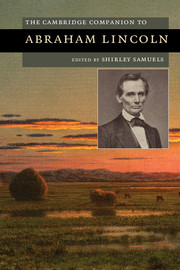Book contents
- Frontmatter
- Introduction
- 1 Rhetorically Lincoln: Abraham Lincoln and Oratorical Culture
- 2 Abraham Lincoln and Poetry
- 3 Seeing Lincoln: Visual Encounters
- 4 Lincoln's Gettysburg Address and Second Inaugural Address
- 5 Lincoln and the Natural Nation
- 6 Abraham Lincoln and the American Indians
- 7 Abraham Lincoln and the Self-Governing Constitution
- 8 Abraham Lincoln and Spiritual Crisis
- 9 America and Britain during the Civil War
- 10 Lincoln in International Memory
- 11 Lincoln's Hemispheric Relations
- 12 Lincoln on Hallowed Ground
- Guide to Further Reading
- Index
12 - Lincoln on Hallowed Ground
Published online by Cambridge University Press: 28 September 2012
- Frontmatter
- Introduction
- 1 Rhetorically Lincoln: Abraham Lincoln and Oratorical Culture
- 2 Abraham Lincoln and Poetry
- 3 Seeing Lincoln: Visual Encounters
- 4 Lincoln's Gettysburg Address and Second Inaugural Address
- 5 Lincoln and the Natural Nation
- 6 Abraham Lincoln and the American Indians
- 7 Abraham Lincoln and the Self-Governing Constitution
- 8 Abraham Lincoln and Spiritual Crisis
- 9 America and Britain during the Civil War
- 10 Lincoln in International Memory
- 11 Lincoln's Hemispheric Relations
- 12 Lincoln on Hallowed Ground
- Guide to Further Reading
- Index
Summary
There was a great battle at Gettysburg. Men screamed and died, and their blood soaked into the ground. The wheels of the artillery wagons dented the earth, and gunpowder scorched the trees. There were no monuments then.
When Lincoln came to speak at Gettysburg, the blood had dried and the screams were silent. There is silence now, and the dead have gone into the earth. There are monuments there. There are ghosts. They rose for Lincoln, when he called the dead out of the hallowed ground. When we read the Gettysburg Address we find ourselves on that same hallowed ground. Our ground, our land, is not on earth alone. Our people are not all numbered among the living.
Americans are a people whose homeland is the text. Our allegiance goes not to a land whose boundaries and contours change, but to words: to the words of the Declaration of Independence, the Constitution, and the Gettysburg Address. Those words have made us. It is to those words, those ideals, those promises, those aspirations, that we give our first and most enduring loyalties. The Gettysburg Address has become one of the canonical texts of the American nation. Generations of students, myself among them, were taught to recite it as a kind of republican catechism. In this text, which grounds our nationality, this text that is our American earth, we find ourselves among the dead.
- Type
- Chapter
- Information
- The Cambridge Companion to Abraham Lincoln , pp. 195 - 208Publisher: Cambridge University PressPrint publication year: 2012



